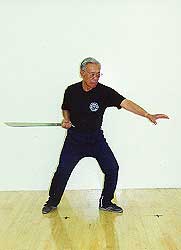20th-Century Arnis
The Reemergence of a Warrior's Art
(Part 2)
By Mark V. Wiley
In 1960, Romeo Mamar founded the art of tapado which utilizes a forty-three
inch staff held at one end with both hands. The art has only two movements
in its repertoire, and they are simultaneously blocks and strikes. Mamar
founded this art in Taloc, Bago City after having become disheartened
by the limitations of the four methods of arnis, lagas, sinamak, layaw,
and uhido, he previously learned. In 1963 the Samahan sa Arnis ng Pilipinas
sponsored the First National Arnis Festival. This festival was important
as it was the first time that the Filipino martial arts were televised
for all to see. Various demonstrations of arnis were given by experts
from Far Eastern University and the Tondo School of Arnis, which was founded
by Jose Mena.

After studying thirteen styles of arnis, Mena developed a personal style
called doblete rapillon or, simply, Mena arnis.
The year 1966 was another eventful for arnis in Cebu City. Florencio Roque
founded the Tornado Garote Self-Defense Club to promote Tatay Ensong's
bahad style, which Roque studied in the 1930s. Magdaleno Nolasco founded
the Black Cat Judo Club. 
By 1973 Magdaleno had incorporated escrido-the martial art of Ciriaco
"Cacoy" Cañete - and changed the name of his club to
the Black Cat Self-Defense Club.

Also in 1966, Angel Cabales,with the assistance of students Max Sarmiento
and DentoyRevillar, opened the first "commercial" eskrima academy
in the United States in Stockton, California.

Leo Gironfollowed soon with his Bahala Na Filipino Martial Arts school
in Tracy, California.
In 1968, Bakbakan International was founded by a number of martial artists
in Manila, as a brotherhood of martial artists in the Philippines. Since
it founding Bakbakan has promoted Filipino martial arts around the world
through the opening of clubs, sponsoring of seminars, the editing and
publishing of books and newsletters, and the production of instructional
video tapes. Then in 1969, under the encouragement of then director and
secretary-treasurer of the Philippine Amateur Athletic Federation, Colonel
Arsenio de Borja, arnis was offered as part of the curriculum for a Bachelors
of Arts degree in the physical education program at Manila s National
College of Physical Education.
The 1970s marked another important decade for the growth and spread of
martial arts in the Philippines.
In 1972, Felimon Caburnay,an original Doce Pares Association
member, founded the Lapunti Self-Defense Club. With his proficiency in
Western fencing, eskrima, combat judo, and wrestling, Caburnay founded
a system known as lapunti arnis de abaniko. 1972 also hosted the founding
of yaw-yan, an acronym of sayaw kamatayan (dance of death). Yaw-yan is
a Filipino kicking style developed by Napolean "Nap" Fernandez. Association
member, founded the Lapunti Self-Defense Club. With his proficiency in
Western fencing, eskrima, combat judo, and wrestling, Caburnay founded
a system known as lapunti arnis de abaniko. 1972 also hosted the founding
of yaw-yan, an acronym of sayaw kamatayan (dance of death). Yaw-yan is
a Filipino kicking style developed by Napolean "Nap" Fernandez.
 Unlike
the similarities to Korean and Japanese kicking styles held by sikaran,
the techniques of yaw-yan are more closely allied to those of muay Thai.
During this year in the United States, pekiti tirsia arnis grandmaster
Leo T. Gaje founded the Arnis America Organization in New York. Unlike
the similarities to Korean and Japanese kicking styles held by sikaran,
the techniques of yaw-yan are more closely allied to those of muay Thai.
During this year in the United States, pekiti tirsia arnis grandmaster
Leo T. Gaje founded the Arnis America Organization in New York.
In 1975, the National Arnis Federation of the Philippines (NARAPHIL) was
organized by General Fabian Ver. At that time General Ver was the Chief
of Staff of the Armed Forces of the Philippines and became NARAPHIL s
first president. The Philippine Arnis Confederation was also founded in
this year by Crispulo "Ising" Atillo. The goal of the Confederation
was to expand on the techniques of their grandmaster, Teodoro "Doring"
Saavedra, also an original member of the Doce Pares Association. The Punta
Princesa Eskrima Club was also founded in 1975 by Artemio Paez, Felipe
Atillo, and Carlos Navarro. The United States had its first full-contact
arnis tournament also at this time. The event was held in New York and
was organized by Amante "Mat" Mariñas and supported by
Florendo "Vee" Visitacion.

Visitacion, interestingly, has founded quite a number of martial arts
over the past forty years, Filipino and otherwise. Most notably, though,
are his Vee arnis and Vee-arnis-jitsu systems.
|